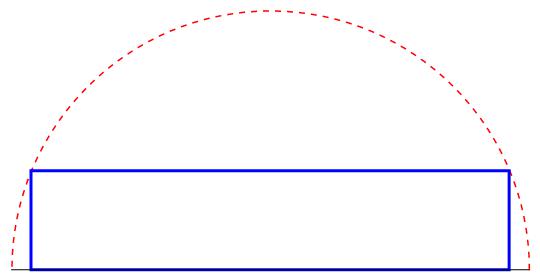The problem can be stated as a maximization/minimization.
Find maximum/minimum of
#S(x,y) = 2pi x y+2 pi x^2#
subjected to
#x^2+y^2=r^2#
#y > 0#
Introducing a slack variable #s# to transform the inequality restriction into an equality equivalent restriction we have
#g_1(x,y) = x^2+y^2-r^2 = 0#
#g_2(x,y) = y-s^2=0#
The lagrangian is
#L(x,y,lambda_1,lambda_2,s) = S(x,y)+lambda_1 g_1(x,y) + lambda_2 g_2(x,y,s)#
being analytic, the stationary conditions are given by
#grad L(x,y,lambda_1,lambda_2,s)=vec 0#
giving
#
{
(2 lambda_1 x + 4 pi x + 2 pi y = 0),
(lambda_2 + 2 pi x + 2 lambda_1 y = 0),
( x^2 + y^2 -r^2= 0),
(y -s^2= 0),
(2 lambda_2 s = 0)
:}
#
Solving for #x,y,lambda_1,lambda_2,s# we obtain
#
(x= -r, y= 0, lambda_1= -2pi, lambda_2= 2pi r, s= 0),
(x = r, y = 0, lambda_1= -2pi, lambda_2 = -2pi r, s = 0),
(x= -r/2 sqrt[2 -sqrt[2]], y=r/2 sqrt[2 + sqrt[2]], lambda_1 =(sqrt[2]-1)pi, lambda_2 = 0,
s ne 0),
(x=r/2 sqrt[2 + sqrt[2]], y= r/2 sqrt[2 - sqrt[2]], lambda_1 =-(sqrt[2]+1)pi, lambda_2 = 0,
s ne 0)
#
As we kow the active restriction is #g_1(x,y)# so, the stationary points qualification is made over
#f_{g_1}(x)=2 pi x^2 + 2 pi x sqrt[r^2 - x^2]#
having a minimum #(d^2f_{g_1})/(dx^2)>0# at
#
(x= -r/2 sqrt[2 -sqrt[2]], y=r/2 sqrt[2 + sqrt[2]], lambda_1 =(sqrt[2]-1)pi, lambda_2 = 0,
s ne 0),
#
and maximum #(d^2f_{g_1})/(dx^2)<0# at
#
(x=r/2 sqrt[2 + sqrt[2]], y= r/2 sqrt[2 - sqrt[2]], lambda_1 =-(sqrt[2]+1)pi, lambda_2 = 0,
s ne 0)
#
The maximum value being
#S(r/2 sqrt[2 + sqrt[2]], r/2 sqrt[2 - sqrt[2]]) = (1 + sqrt[2]) pi r^2#
If #r = 1# then #S(1/2 sqrt[2 + sqrt[2]], 1/2 sqrt[2 - sqrt[2]]) = (1 + sqrt[2]) pi#



